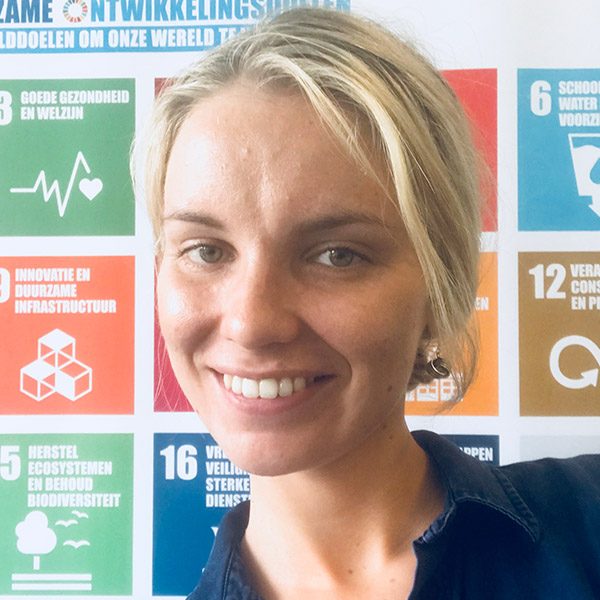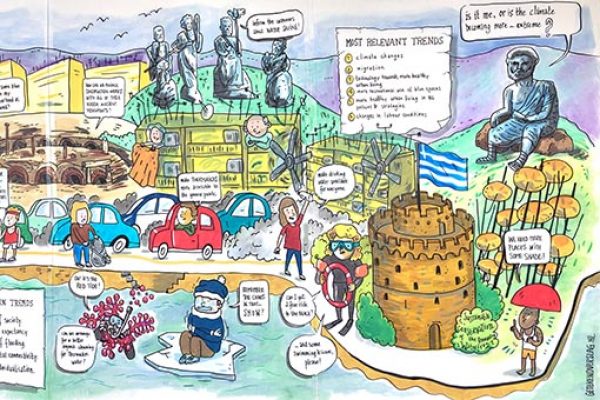Introduction

Blue spaces for healthy and resilient cities
Waterways like rivers, canals and coastlines are important assets for many cities. Waterways may be advantageous for tourism, trade or as a part of the cultural identity of a city. But water can also be beneficial to public health.
Like green spaces, urban blue spaces contribute to a healthy lifestyle and have been proven to promote a range of activities that benefit health and well-being. To foster blue spaces that promote the health of citizens, local policy makers and stakeholders need to work together.
Scroll down as we explain why, or skip straight to:
How people use urban blue spaces
Climate conditions like the number of warm and sunny days, information on the population (age, cultural background, gender) and the presence of tourists give an indication of how blue spaces might be used. That could be for swimming, rowing, surfing, stand up paddling (SUP), sailing, diving, fishing, walking or just sitting alongside the waterfront, enjoying the view or as a meeting place.
On the other hand, trends like increased flooding due to climate change, economic growth, urban development and shipping can result in the inability of using blue spaces. Including the possibility of increasing water pollution or dangers related to its use, like the risk of drowning.
This may hamper the use of urban water for health now and in the future. That is why collaboration between different stakeholders, such as inhabitants and policy makers, is so important to maximise the health benefits of blue spaces.
Global change and local values impact the environment
So far the impacts of global trends related to for instance climate change, economy and demography have been studied at a continental or national level and policy development is often based on these high-level studies that focus on a global level.
The implications of global trends on a local level are barely understood to date. However, local authorities need to take action now in their cities to anticipate the impacts of future trends to keep their citizens healthy and safe.
Values and ambitions shape the course of action taken by local decision makers. That is why we think it is important to understand which normative perspectives are dominant in a city, amongst local stakeholders and policy makers. Because that shapes the direction of policy planning and the selection of issues that are valued as important to act upon.
Research highlights
- Global trends that ongoingly impact urban blue spaces are diverse. They need to be understood at the local level by generalists to make well-informed policy decisions.
- Urban problems, issues and impacts faced by cities, are intrinsically linked to local values and ambitions which inform urban decision making.
- Policies for healthy blue spaces should be informed by those concerned with public health, water governance, biodiversity, social inequalities and economic insights.
- Inter-sector and interdisciplinary partnerships enhance the planning, management and decision making for health-promoting blue spaces.
Pan-European comparison

Global trends and local impacts
Cities have individual characteristics that determine the local ‘norm’. The local impact of global trends for a city or place within Europe depends on the geographical location of a place, it’s climate, demography, economic developments, social and cultural characteristics, local nature and environment, available technology and the local and nationwide governance structure and legislation.
Local impacts of climate change
Climate change is one example of a global trend that will affect the whole of Europe, but impacts will vary for different cities and regions. More extreme periods of heat, drought and water shortages will impact southern European cities. While in Northern and Western Europe, periods of heavy rainfall and the risk of flooding will create new challenges. Increasing social inequalities is another trend across Europe. Yet inequalities are defined at a local level by social structures, economic status and bureaucracies.
Policies developed to pursue pressures on society, therefore differ from place to place. Not just because of localised governance structures and legislation, but also according to local priorities and the specific ambitions of local society. Legal frameworks also vary between cities. While on the European level the importance of cities as healthy living environments is recognised, this must be elaborated on to inform national and local policies.
Local values, ambitions and decision making
The perspectives of local stakeholders and policy makers help to shape the direction of policy planning at a city level. These are informed by local values and ambitions, which play an important role in determining how cities prioritise healthy living environments.
Cities rated their top global trends and local values
In scenario workshops, we asked participants to rate their top global trends related to healthy blue spaces and the top two local values and ambitions that impact decision-making in their city. This has highlighted differences and similarities between cities as shown in the two images below (visit this pdf for text format).

The most pressing global trends to impact health and blue spaces as rated by workshop participants.
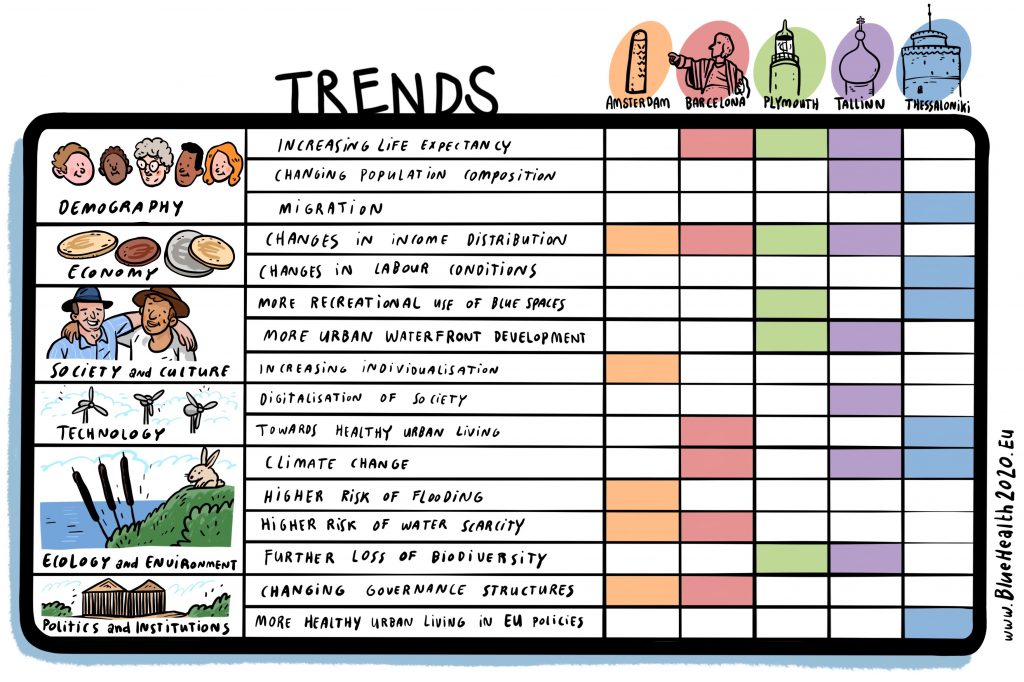
Global trends that could impact society between now and 2040 were selected for each city.
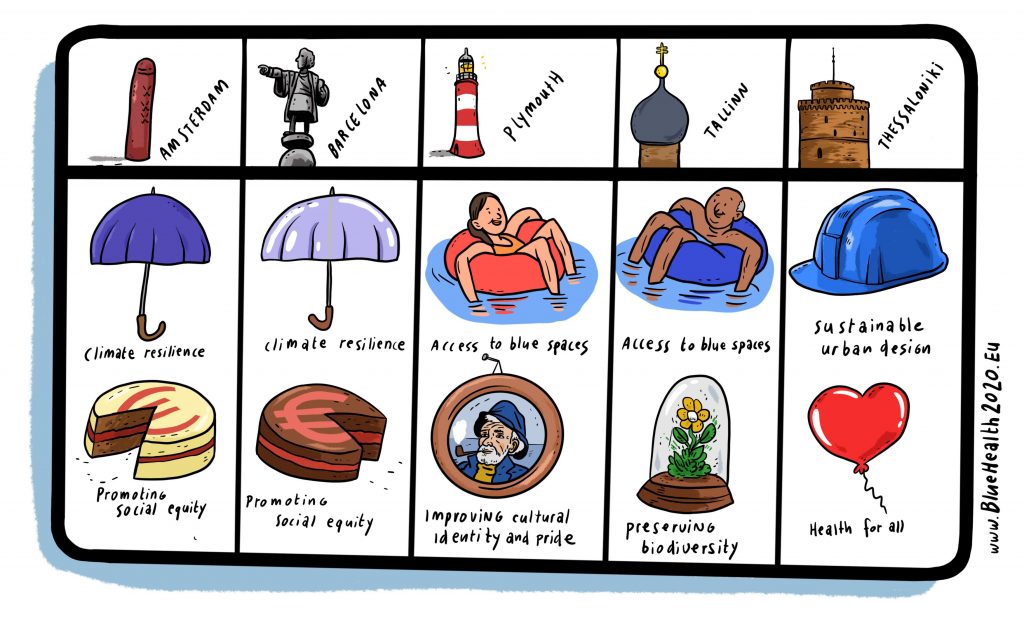
Workshop participants highlighted two local values that impact urban decision making.
Similarities and differences between local challenges
Identifying the impacts of global trends combined with local values and ambitions helps to create narratives about how individual cities and regions can prepare for future challenges. Through participatory workshops, the following prominent narratives were identified:
Economies and employee pull factors
Some European cities appear to be a magnet for higher educated employees from within and outside the country. The presence of companies and available technology in combination with a favourable social-cultural living environment attracts these higher educated employees. Other cities are struggling economically, partly due to the disappearance of traditional industries and the fact that well-educated employees move to other cities.
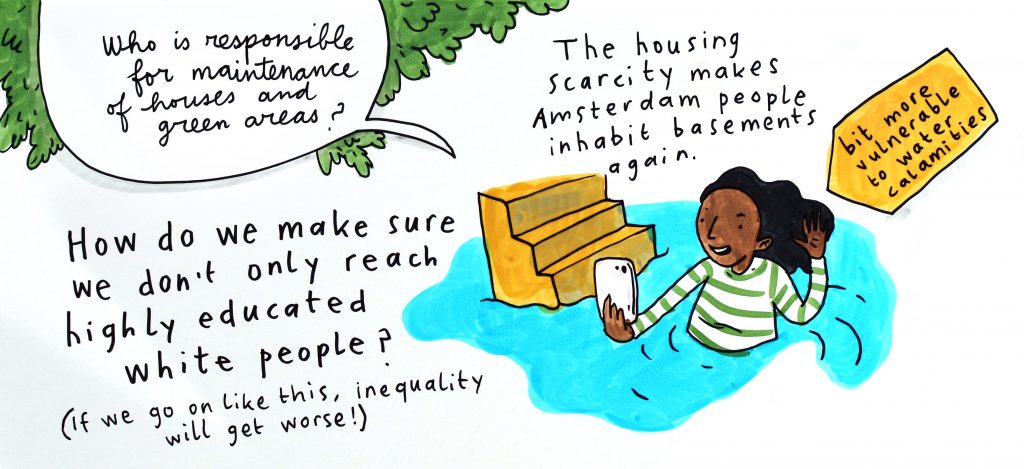
Decision making in cities is impacted by a variety of local factors (Amsterdam workshop illustration).
Tourism as an economic driver and societal burden
Tourism is also a challenge for some cities, while for others it forms an opportunity. Inhabitants of Barcelona, for instance, have less access to the beach in summer months as this is a hotspot for increasing numbers of tourists. In Amsterdam and Barcelona, affordable housing for all population groups is under increasing pressure as prices for accommodation are rising, partly caused by rentals for tourists. Other cities in Europe, like Plymouth and Thessaloniki, would like to attract more tourists to strengthen the local economy. They view tourism as an opportunity to create healthy blue spaces that can benefit health and the economy.

Tourism can add societal pressures despite being an economic driver (Barcelona workshop illustration).
Access to blue spaces
For many cities, the presence of water is an important opportunity, as it is attractive for people to live and recreate at/on the water (side). Yet, a pressing question to these cities is how to guarantee access for all to these healthy blue spaces and keep them healthy. Stakeholders reported that developing the coastal area in Plymouth has advantages to attract tourists and second homers, but the coast might become less accessible to other residents.
Space is scarce, especially in cities. This requires cities to make choices and find solutions that can serve multiple purposes. For example, water infrastructure can be designed to be climate-resilient, while also promoting health and wellbeing. However, it is also important to understand any possible negative consequences that could impact the environment or health as a result of decisions, actions and policies.

Urbanisation can impact access to blue spaces (Plymouth workshop illustration).
Opportunities
- Through health-promoting blue infrastructure, spaces can be designed and managed to co-benefit society and the environment. For example, mitigating the effects of urban heat islands while also creating spaces that promote physical activity and protect ecosystems.
- Representative research, surveys and workshops can be used to determine a city’s values and impacting global trends, including the policies and strategies that have been evolved because of them. This can lead to creating more co-benefits between health and the environment.
- Through analysis of a city’s characteristics, we can better understand how blue spaces are values, impacted and how decisions might be made.
- With knowledge exchange and collaboration between sectors and disciplines, health-promoting blue spaces can help a city mitigate future risks.
Scenarios methodology

A participatory interactive approach was used to promote inter-sector and interdisciplinary collaboration.
Our goal was to identify how decisions and actions are determined in different cities across Europe. Plus how decisions and actions are linked to local values, ambitions and global trends. We combined research and workshop discussions to identify how blue spaces promote health and the environment in different cities, also highlighting what risks need to be considered to ensure healthy and resilient cities and adapt to current and future challenges.
Scenario workshops
Five ‘scenario workshops’ were hosted in the cities of Amsterdam, Plymouth, Barcelona, Tallinn and Thessaloniki.
For each workshop, a diverse group of local stakeholders was invited, who work in the health, economic, policy, water or ecological sector. Discussions that led to the exchange of knowledge, ideas and uncovered sectoral and city-wide ambitions for each city were the focus of these workshops.
People shared the trends impacting their city and their perspectives on how to deal with these trends, taking local values and ambitions into account.
The discussions helped to identify existing and potential future policies that benefit multiple win-win goals, helping to tackle issues relating to social inequalities, health and wellbeing, education and a sense of place and pride. For example, stakeholders from the coastal city of Plymouth highlighted the need to remember they are an ocean city, and to include the elderly in education activities to emphasise the importance of the sea.
Interpreting workshop scenarios
An illustrator summarised the discussions from each workshop, creating a visual city shaped from ‘future scenarios’. Each illustration depicts the factors most likely to impact the city and the priorities that policy and decision-makers can respond to.
Alongside local recommendations, this knowledge helped us to define overarching narratives about the risks and benefits facing Europe’s cities.
We invited a broad range of stakeholders to each workshop from different policy domains and sectors, in order to gather knowledge on trends and BlueHealth issues from multiple perspectives.
However, we were not able to get all the relevant domains to participate during each workshop, which might have influenced the selection of trends and values that were chosen for each city. This is why existing policy documents and future plans were used as additional material to create a future scenario for each city.
Summary
This research has started to fill in the gaps about how blue space in Europe’s cities is linked to health and wellbeing now, and how this could change in the future. Participants shared that they now feel better prepared to recommend strategies and solutions to local authorities and decision makers, to ensure they take action to preserve blue environments and keep their communities healthy and safe.
Limitations
Uncertainty about future developments and trends is inherently a part of scenario studies. In the case of the BlueHealth scenarios and narrative, this means we have not included any consequences of the current situation that Europe and the rest of the world are facing with regards to the spread of the new coronavirus.
Therefore, the possible consequences of the coronavirus situation for future (local) policy making are not taken into account in this study. All scenario workshops and policy document analyses were carried out before January 2020.
Future BlueHealth research
The outcomes of the workshop serve as input for future policy plans, but also support questions regarding transferability of cases from one location to another. Stakeholders helped us to identify the knowledge and data gaps that need to be filled to develop future ‘blue health’ strategies and interventions. We identified that knowledge is limited regarding the interaction of urban blue space and health-related issues like social inequalities on the local level. There is also little knowledge of transferability from one case to another.
Continuing to advance our knowledge of how health and wellbeing are connected to blue environments will make us better placed to transfer this knowledge from one city to another, to make them healthier and more resilient places in the future.







